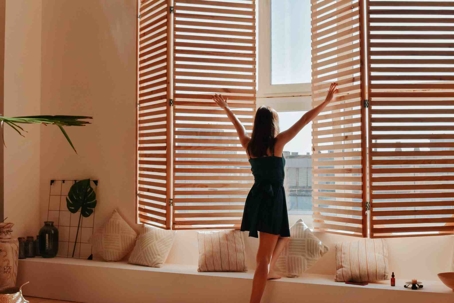Choosing the Right Window Treatments for Effective Light Control: A Guide to Light Filtering, Room Darkening, and Blackout Solutions
There are a variety of factors to consider when purchasing new window coverings. On this blog site, we offer expertise to help you consider them all. In our last blog, we explored the best window treatments for energy efficiency. In this installment, we identify which window covering options are best for light control.
They might seem like the same thing initially. But they’re not. Not surprisingly, some window coverings perform well in both the light control and energy efficiency categories while some are optimized for one or the other; or neither! I’ll explain.
Light control is important for different reasons. The three most common objectives are: 1) Creating a completely dark room for improved sleeping conditions, 2) Limiting direct UV light from hitting furniture and carpet which can cause fading and damage, and 3) Reducing glare in living areas which impacts both living comfortability and TV viewing experiences (according to my wife, the latter is the most important factor by far!)
So, what properties in a window covering can make it effective at light control? There are a few:
- Overall design. Does the window covering have design elements that help control light?
- Material type and opacity. Opacity is a measure of how much light comes through the fabric or material of a window covering.
- Does the window covering operate in a way that gives you the ability to control light?
Now that you know the properties some window coverings have to more effectively control light, consider the Top 4 window treatments for light control (plus a bonus combination), why they are effective, and what their best use case is.
Honeycomb/Cellular Shades
Cellular shades are a good choice for light control for two reasons. First, the design of the shades lends itself to producing minimal light gaps. The fabric panel of the shade can go almost entirely to the end of the headrail from which it hangs. This means there is little light leakage around each side of the shade. In addition, customers who want to block even this small light gap can add light block strips behind the shade.
Next, cellular shades are offered in different opacities by all manufacturers. For customers wanting to cut glare but still obtain different degrees of natural light, light filtering and room darkening materials are a good fit. For customers who want complete darkness in a room, blackout materials are best. Blackout cells are created by adding lining to the inside of the fabric cells. This material along with light block strips are a good way to achieve almost complete darkness.
Roller Shades
Roller shades are another product that can offer multiple light control outcomes. Roller shades aren’t quite as effective as cellular shades when it comes to overall design. They inherently have a slightly larger light gap than cellular shades along both sides. However, they do have several add on features that can improve light control. These features are top treatments (known as Cassettes, Valances and Fascias) that block out light gaps at the top of the shade. They also offer light gap strips to block the light that comes in around the sides of the shade.
Roller shades offer a wide variety of opacity fabrics. Looking for a light filtering shade that lets in natural light? You will have many options. Looking for a blackout fabric along with the light control features previously mentioned to achieve near blackout conditions? You are set.
Lastly, a trick that can be used with roller shades is outside mounting. This means you mount the shade outside and above the window opening. When done properly, this can almost entirely block out every sliver of light.
Shutters
What Shutters lack in overall design, they make up for in opacity and functionality. Solid wood and faux wood slats have a 0% opacity meaning no light passes through the actual material. However, the slats will inevitably let through slivers of light.
This makes shutters a great option for bringing natural light into a space (with louvers in the upward facing tilt position) while still preventing direct light on your furniture. Full blackout won’t be achievable with this product, but it may be the right product for you if light control is more important than light blocking.
Drapery
Drapery is the star of the show when it comes to light control and black out conditions. It excels in all three categories: design, opacity, and functionality. You can use inside mount draperies in a light filtering fabric if your goal is to limit direct UV light contact on your furniture. Conversely, if you’re looking for blackout conditions for your bedroom, outside mounting a fabric with blackout lining is the single best way to achieve it. By overlapping the drapery on either side of the window opening and using a blackout fabric, you become the master of light control.
Bonus Combo: Roller Shades and Drapery TOGETHER!
We have explored the use cases and effectiveness of roller shades and drapery as independent window coverings. When used together, they provide every element of light control. Picture a light filtering roller shade inside your window or windows. When fully opened, 100% of light enters the room. When closed, it creates a light filtering or room darkening environment (depending on opacity of the fabric) allowing natural light into your room but preventing some of the harmful effects of direct light contact. Lastly, picture closing a blackout-lined, outside-mounted drapery over the window or windows in questions. You have created a window covering experience that not only looks great, but allows for all three versions of light control.
Now that we have “shone some light” (pun intended) on how different window covering products perform different light control objectives, you can create the space you want with confidence. Your local and trusted Bumble Bee Blinds professional can assist you. To find a Bumble Bee Blinds location in your local area, click here.
Luke Schwartz is the Brand President of Bumble Bee Blinds. He and Stephen Vest, the owner of Bumble Bee Blinds’ founding location, come from families with more than 60 years of experience in the window covering industry. Each month, Luke shares this experience and perspective through informative blogs about the window covering industry to educate our customers about products, features, and questions to consider when buying window treatments. Regular readers hopefully won’t have to ask, “Where do I start?” when in the market for window coverings.



